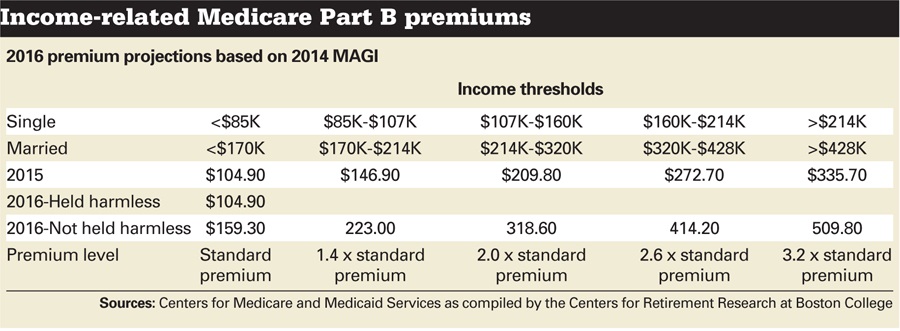By now, most Crain's Wealth readers know that there probably will not be a cost-of-living adjustment in Social Security benefits next year (as I first reported last month). This would be only the third time in the past 40 years that no COLA would be paid on Social Security benefits.
Those same readers also know that some of you — including high-income retirees, those of you who elected to suspend your Social Security benefits and new Medicare enrollees in 2016 — will pay higher Medicare premiums next year.
Now, a new analysis from the Center for Retirement Research at Boston College details just how steep some of the premium hikes might be in 2016. It also discusses the broader implication of rapidly rising Medicare premiums undermining the ability of seniors to maintain their buying power for non-medical-care spending.
Advertisement
But first, a mini refresher course on the situation.
The decision not to increase Social Security benefits in 2016 is the result of low inflation over the past year. No Social Security COLA means no Medicare premium hike for most beneficiaries.
That's because the Social Security Act contains a "hold harmless" provision that protects the vast majority of Social Security beneficiaries from paying a larger increase in Medicare Part B premiums than they receive in Social Security COLA increase in order to avoid a reduction in their net Social Security benefit. Normally, Medicare Part B premiums are deducted from monthly Social Security benefits.
But the hold-harmless provision does not apply to Medicare beneficiaries who are subject to premium surcharges because their modified adjusted gross incomes tops $85,000 for individuals or $170,000 for married couples. Neither do the hold harmless protections apply to Medicare beneficiaries who are not yet collecting Social Security benefits, including those who chose to suspend their benefits, nor to new Medicare enrollees in 2016.
There are five Medicare premium brackets. In 2015, the surcharges range from $42 to $230.80 per month on top of the standard $104.90-per-month premium. These premiums apply per person, so married couples where both spouses are Medicare age would pay twice as much. Anyone who is subject to Medicare premium surcharges is not protected from future Medicare increases.
The MAGI brackets — which include AGI plus any tax-exempt interest — are based on your latest tax return. A 2014 tax return filed in 2015 will be the basis for the Medicare premiums paid in 2016.
The recently released 2015 Social Security and Medicare Trustees report projected a 52% increase in Medicare Part B premiums for 2016. The actual increase will be announced by the Department of Health and Human Services in the fall. But because about 70% of retirees are protected by the hold harmless provision, the burden of any increased premium must be borne by just 30% of beneficiaries.
The majority of Medicare beneficiaries will continue to pay $104.90 per month for Medicare Part B in 2016. But if HHS increases Medicare Part B premiums by 52% as projected, new enrollees in Medicare, as well as Medicare beneficiaries who are not yet collecting Social Security benefits, are likely to pay $159.30 per month next year, assuming their MAGI is below the $85,000/$170,000 income triggers.
But higher-income retirees could see substantial premium hikes in 2016 — as much as $404.90 more per month per person compared to this year's base Medicare premium, according to the Center for Retirement Research.
“This year's Medicare flap highlights a broader issue concerning the difference between Social Security's COLA and the percentage increase in the Medicare premium,” the CRR analysis said.
“If the two increases were equal, the disposable income beneficiaries had for non-health items such as food, shelter and clothing would automatically keep pace with non-health inflation,” the analysis noted. “But the premium has on average risen over twice as fast as the benefits.”
Medicare Part B premiums have increased an average of 5.7% per year from 2000 to 2014 compared with an average Social Security COLA of just 2.4% per year during the same period, according to the CRR report.
“Rapidly rising Medicare premiums undermine the ability of the elderly to maintain their non-medical-care spending,” the report concluded.
While most Medicare beneficiaries will be protected from a premium hike next year, many will have to dig deeper to cover their health care costs in 2016.
(Questions about Social Security? Find the answers in my ebook.)
Mary Beth Franklin is a certified financial planner.








